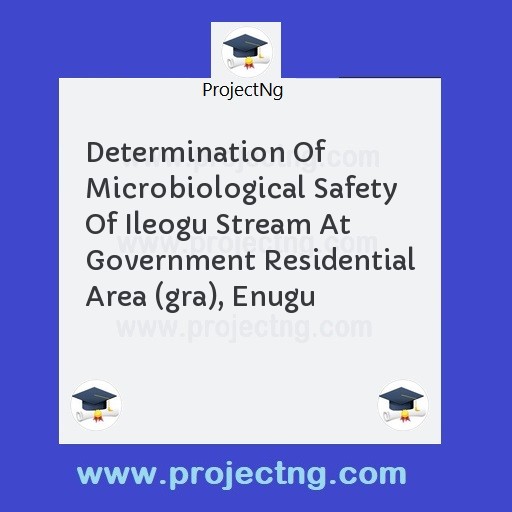Determination Of Microbiological Safety Of Ileogu Stream At Government Residential Area (gra), Enugu
Science Lab Technology Project Topics
Get the Complete Project Materials Now! »
DETERMINATION OF MICROBIOLOGICAL SAFETY OF ILEOGU STREAM AT GOVERNMENT RESIDENTIAL AREA (GRA), ENUGU
ABSTRACT
Determination of Microbiological safety of Ileogu Stream at Government Residential Area (GRA), Enugu was conducted. Ten samples of the water from various parts were examined for total viable count for the presence of both paikogenic organisms and organisms of indicating organic matter pollution. Also the same ten samples were used to detect coliform groups and Escherichia Coli, using presumptive coliform test, confirmatory test and completed test techniques.
The mean total viable count for paikogenic organisms was 12cfu perml mean count for organisms indicating organic matter pollution was 16cfu per ml. At presumptive test showed presence of Coliform groups in seven samples out of ten, the confirmatory test showed presence of both Coliform and Escherichia Coli in eight samples out of the ten samples.
Whereas the completed test showed mean count of Coliform group as 9 cfu per ml and mean count for Esterichia Coli as 16 cfu per ml. The result showed that Ileogu Stream was polluted and also faecally contaminated. Therefore this stream is not fit for drinking purpose. Though can be used for washing clothes and bathing, since the microbial load was minimal.
TABLE OF CONTENTS
Title page
Certification page
Dedication
Acknowledgement
Abstract
Table of content
CHPATER ONE
1.0 INTRODUCTION
1.1 Aim of the Study
1.2 Objective of the Study
1.3 Statement of Problem
1.4 Limitation of the Study
1.5 Hypothesis
1.6 Significance of the Study
CHAPTER TWO
2.0 LITERATURE REVIEW
CHPATER THREE
3.0 MATERIALS AND METHODS
3.1 Materials
3.2 Methods
3.2.1 Sterilization
3.2.2 Collection of Water
3.2.3 Preparation of Culture
3.2.4 Plating Techniques for Water Analysis
CHAPTER FOUR
4.0 RESULTS
CHAPTER FIVE
5.0 DISCUSSION
CHPATER SIX
6.0 CONCLUSION AND RECOMMENDATION
REFERENCES
CHAPTER ONE
1.0 INTRODUCTION
According to McGhee (1991), a stream is a flow of water, which moves, in a particular direction into a river or drainage. Stream water is formed as a result of rainfall and runoff. It can also be called a small river. For many years, water in streams and other surface waters have been polluted by nature. Steams are turbid because of the silt and clay they transport as part of the earth’s erosion cycle.
Apart from stream water, there are other sources of water supply. They include well water (ground water), rivers, seas, oceans, rainfall, spring and reservoirs. Water generally is composed of different materials such as living organisms, solid organic substances and inorganic substances. But steam water is mainly of faecal materials, contaminated food and living organisms like bacterial organisms which cause diseases such as typhoid, paratyphoid, salmonellas, bacillary dysentery, cholera and Pontiac fever.
Virus organisms cause diseases associated with water and these are hepatitis, poliomyelitis and gastroenteritis attributable to Norwalk viruses and rotaviruses. Protozoans such as giardia and cryptosporiduim can cause gastroenteritis and they are very resistant to disinfectants. Certain fungi, notably schistosomiasis is human pathogens caused by worm, which result to liver fluke. A great majority of microorganisms are found in water most being of health significance. These organisms are transmitted primarily through faeces and urine of infected persons who one-way or the other discharge these organisms into the stream, thereby making it unfit for consumption (mokeinath, et al 1985).
1.1 AIM OF THE STUDY
The aim of the study is to determine the microbiological safety of Ileogu stream at G.R.A Enugu.
1.2 OBJECTIVES OF THE STUDY
i. To isolate bacterial contaminants of Ileogu stream at G.R.A Enugu.
ii. To determine if Ileogu steam is faecally contaminated
iii. To identify the bacterial types.
iv. To determine the microbial load of Ileogu stream.
Be the First to Share On Social

Enjoying our content?
Don't miss out on new videos! Subscribe to our YouTube channel for more awesome content.
Subscribe Now!













